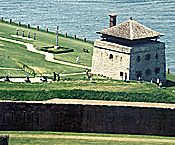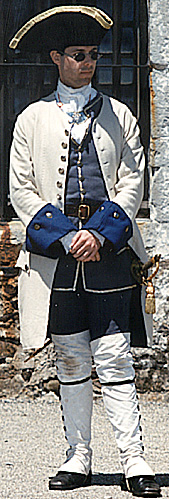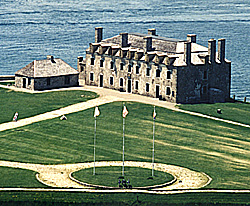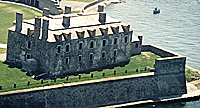 The peninsula that Old Fort Niagara occupies has been inhabited in various
ways for some 12,000 years. First by the native Indian population and then
by Europeans. The Indians of the Neuter Tribe had been evicted by the
Seneca Indians only 29 years (circa 1650) before the arrival of the first
French explorers. The French explorer La Salle obtained permission of the
Seneca Indians in 1679 to build a trading house on the site. La Salle
called the post Fort Conti.
The peninsula that Old Fort Niagara occupies has been inhabited in various
ways for some 12,000 years. First by the native Indian population and then
by Europeans. The Indians of the Neuter Tribe had been evicted by the
Seneca Indians only 29 years (circa 1650) before the arrival of the first
French explorers. The French explorer La Salle obtained permission of the
Seneca Indians in 1679 to build a trading house on the site. La Salle
called the post Fort Conti.
 It was a rough affair consisting of two 40
foot square redoubts or blockhouses connected by a wooden palisade. This
site probably occupied the general area where today stands the La Salle
monument and the French Castle within the existing fort's walls. This post
was destroyed by fire in that same year.
It was a rough affair consisting of two 40
foot square redoubts or blockhouses connected by a wooden palisade. This
site probably occupied the general area where today stands the La Salle
monument and the French Castle within the existing fort's walls. This post
was destroyed by fire in that same year.
The Marquis Denonville renewed French control of the place in 1687 constructing Fort Denonville on the same location of Fort Conti. Completing the new fort Denonville left a garrison of 100 men. A year later Father Pierre Millet arrived to relief the first garrison only to find 12 survivors. Father Millet erected a wooden cross in the fort somewhere between the Castle and the Millet Cross.
By fall of 1688 the new garrison was removed due to British protests and the logistical realities of maintaining a garrison during the winter months. It would be another 37 years before the peninsula would see another fortification.
Around 1701 the British managed to secure trade rights from the Seneca Indians. This area extended from what is now Western New York including the Niagara peninsula. Although the British did not actively pursue this trade concession the French felt that the area was part of New France and utilized the area as a trade route from Montreal to the Mississippi river basin.
Louis Charbert de Joncaire and his brother, Thomas, established a French trading post along the Niagara River near modern Lewiston, New York in 1720. Returning to the Niagara Peninsula the Chief Engineer of New France, de Lery began construction of a supposed trading house; a "House of Peace" on the present site; this building is the center piece of the existing fort we see today.
 Today it is called "the French Castle" in literature, in fact it was a "Maison a Machicoulis" or fortified house. Indeed it does have the marks of being a house in its general appearance.
It was a solid stone building made from material ferried across Lake
Ontario from modern Kingston, Ontario, Canada, then called Fort Frontenac.
Today it is called "the French Castle" in literature, in fact it was a "Maison a Machicoulis" or fortified house. Indeed it does have the marks of being a house in its general appearance.
It was a solid stone building made from material ferried across Lake
Ontario from modern Kingston, Ontario, Canada, then called Fort Frontenac.
The French had secured permission from the Iroquois to build a house (of wood and not stone) consequently the French wished their house to be as unoffensive as possible.
 The Seneca on whose land it was built were not
fooled but their protests went unheeded as construction over a two year
period saw the building completed and then surrounded with a wooden
palisade perhaps an acre in size. While the French may have thought they
had succeed in securing their trade route in years to come the animosity
the Seneca felt toward the French would rear its head during the French and
Indian War of the 1750's. Until that time this one acre would become one
of the keys to the continent.
The Seneca on whose land it was built were not
fooled but their protests went unheeded as construction over a two year
period saw the building completed and then surrounded with a wooden
palisade perhaps an acre in size. While the French may have thought they
had succeed in securing their trade route in years to come the animosity
the Seneca felt toward the French would rear its head during the French and
Indian War of the 1750's. Until that time this one acre would become one
of the keys to the continent.
More Old Fort Niagara
-
Old Fort Niagara Introduction
Forts Conti and Denonville (slow: 175K)
Siege of Fort Niagara during the French and Indian War (slow: 200K)
American Revolution and War of 1812 (slow: 263K)
A Brief Tour of the Existing Buildings (75K)
Conclusion and Contacts (slow: 187K)
Bookstore Buys
Re-enactors and Fort George Photos (very slow: 408K)
Pre-renovation: 1926 Photos (very slow: 268K)
1909 Postcard of Old Fort Niagara (slow: 165K)
Back to List of Battlefields
Back to Travel Master List
Back to MagWeb Master List of Magazines
© Copyright 1997 by Coalition Web, Inc.
This article appears in MagWeb (Magazine Web) on the Internet World Wide Web.
Other military history articles and gaming articles are available at http://www.magweb.com